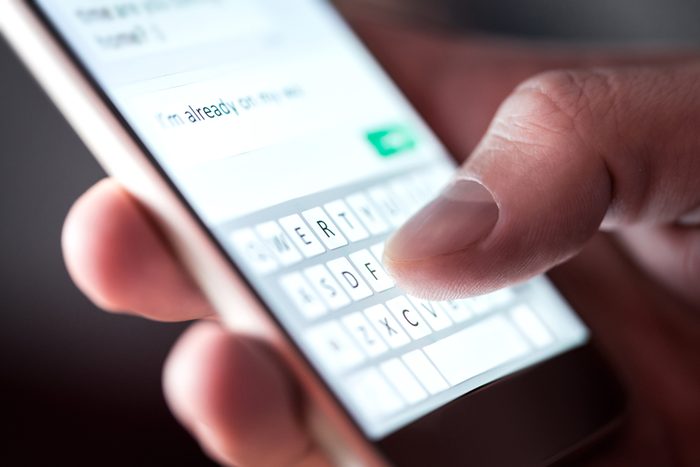
Don’t start a conversation at night
Trying to get to sleep when your phone is buzzing like crazy is the worst. Don’t start a group text conversation at night when everyone probably has somewhere to be in the morning. A good time to start a group text is the late afternoon or in the evening when people are getting home from work and will be free to engage in a conversation. These are the most annoying texting habits, according to science.

Don’t only talk to one person
You know that moment when a group conversation turns into just two people? Avoid that at all costs. You don’t need an audience for your one-on-one conversation. If you have something separate to discuss, take it to a private chat and spare everyone else in the group. Here’s when texting is actually better than calling.

Text people who know each other
Getting a group text with numbers you don’t have is always awkward. You have to ask who it is you’re speaking with, and it tends to get weird. If you have something you want to send to several people who have nothing in common, take the time to text them individually. Or at least introduce them over text. The one time this is acceptable group text etiquette: when you are planning an event that all of the people will be attending. Other than that, avoid throwing everyone into a group of people they don’t know. Be sure to bookmark this helpful guide on texting abbreviations and how to use them properly.

Stay on subject
Group texting is not for mindless chatter. Group texts should have a purpose or a goal. Making plans or sharing an article or funny picture are all reasons to group text with friends or family. Catching up on your day is better discussed individually or in person. You can’t really carry on a normal conversation over a group text because it is so sporadic and rapid with so many people involved. Make sure you have a purpose and stay on subject before hitting send a text to ten of your friends. Don’t miss these 9 things you should never do over text message.

Don’t rush the conversation
Allow everyone to get a chance to talk. When the group is discussing one subject, make sure everyone has contributed to the conversation before moving on to something else. It gets confusing when someone starts talking about a separate topic and everyone is scrolling back to catch up on what’s happening. The conversation will flow so much better if you follow group texting etiquette and give everyone a chance to keep up.

Announce if you are leaving the conversation
Don’t ghost your text message group. If you’re busy or just can’t continue the conversation, let everyone know you’re leaving so they won’t expect a response from you anymore. You know when you don’t look at a group chat for a few minutes and it’s filled with everyone saying, “Where’s Sarah? Did she leave? Hello?” That’s never fun for anyone. Just be considerate and say that you can’t talk. Speaking of group chats, here is how to name one on any device.

Allow the conversation to have an end
The absolute cardinal sin of group texting etiquette is dragging it on and blowing up everyone’s phone for no real reason. When the goal of the conversation has been met, say goodbye and allow the conversation to end. Don’t be that person who keeps texting. No one likes that guy. Here are 50 little life etiquette rules everyone should practice.

Keep your phone on silent
Whether you’re in the office or chilling on the couch with your partner, no one wants to hear your phone buzzing a million times while your friends are chatting back and forth. As soon as a group message starts picking up, put your phone on Do Not Disturb so it doesn’t vibrate or ding with every text.

Participate
No need to drop everything for every single conversation, but don’t be that person who stays eerily silent 90 percent of the time. You aren’t doing your friends any favors if you’re keeping up with the texts and just not bothering to respond. You were included in this group for a reason, and group texting etiquette warrants some sort of reply.

Don’t just add to the noise
Avoid sending texts in rapid succession so that everyone can keep up with the flow of the conversation. Sure, sending “I. Can’t. Even. Believe. This.” as five separate texts gives your messages emphasis, but it also means four extra phone buzzes for everyone on the receiving end. And yes, they will resent you for it. Put all your thoughts (or at least the necessary ones) in a single text instead.
